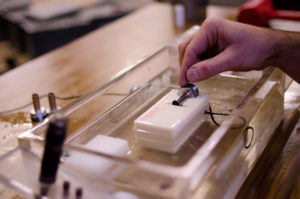You know that your parts require some kind of non-destructive testing inspection, but do you know what is happening to your parts when that test method is applied? Over the next few weeks, our level III technicians will provide an explanation of each NDT method we employ along with some advantages and limitations of each.
This week we continue our series with Ultrasonic testing (UT).
Ultrasonic testing uses high frequency sound waves as a probing medium to inspect metals and nonmetals for surface or subsurface imperfections, thickness, and material characterizations. This is accomplished by using an ultrasonic flaw detector with a piezoelectric transducer. The flaw detector, or ultrasonic unit, is how we control the sound wave sent into the part by the transducer.
uses high frequency sound waves as a probing medium to inspect metals and nonmetals for surface or subsurface imperfections, thickness, and material characterizations. This is accomplished by using an ultrasonic flaw detector with a piezoelectric transducer. The flaw detector, or ultrasonic unit, is how we control the sound wave sent into the part by the transducer.
The unit sends an electrical pulse to a crystal or element with in the transducer. The pulse is very short, but causes the crystal to deform, or tighten up, and then instantly release causing a vibration. The ability to transform electrical energy into mechanical and vice versa is called the piezoelectric effect. This vibration is directed toward the part under inspection. Once the wave strikes the part, the mechanical energy is transferred to the part. This wave travels through the part until an interface or boundary is encountered. At a boundary, a proportionate amount of mechanical energy will be returned to the transducer.
As an example, if you have a block of steel that is solid with no defects, the sound will go into the block, bounce off the back side, and return to the transducer. The time the wave takes to travel that distance is how we can determine thickness. Sound returning more quickly than it should is how we know there is an imperfection in the part.
Contributed by:
Nathaniel Reveal
Project Manager & Ultrasonic Level III Technician